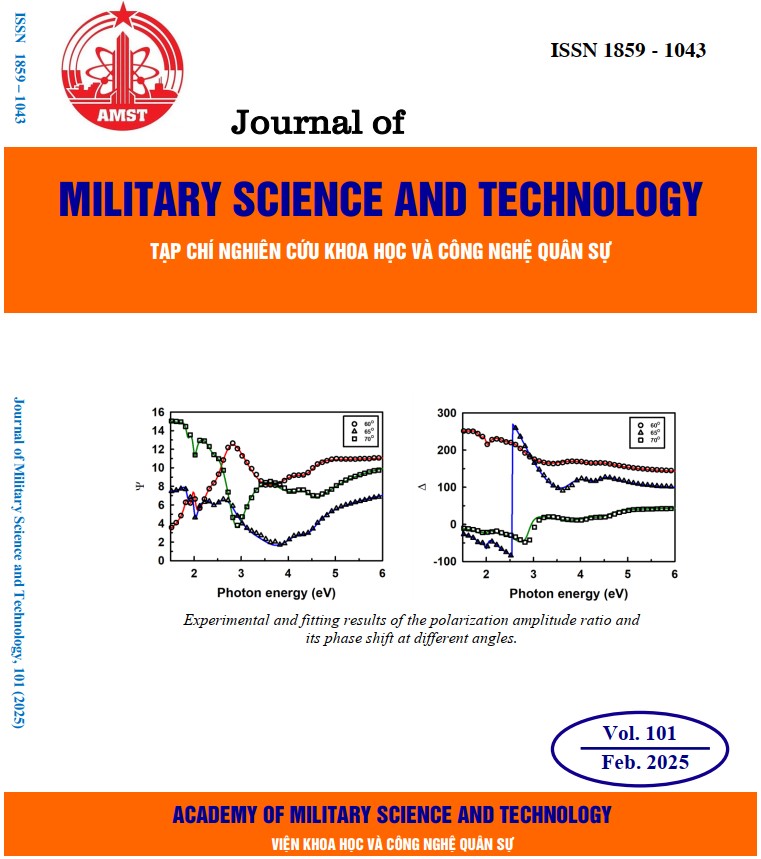Giải pháp giảm thiểu hiện tượng biến dạng kéo dài trên cơ cấu chấp hành điện môi đàn hồi hình trụ
344 lượt xemDOI:
https://doi.org/10.54939/1859-1043.j.mst.101.2025.148-154Từ khóa:
Cơ cấu chấp hành điện môi đàn hồi hình trụ; Biến dạng kéo dài đàn nhớt; Bù đắp biến dạng kéo dài.Tóm tắt
Cơ cấu chấp hành điện môi đàn hồi hình trụ (CDEA) được biết đến như một cấu trúc tự kéo dãn của các cơ cấu chấp hành điện môi đàn hồi (DEA). Tuy nhiên, tính phi tuyến đàn nhớt vốn có của cơ cấu chấp hành dẫn đến hiện tượng biến dạng kéo dài phi tuyến và trễ đàn hồi, gây ra những thách thức trong việc mô hình hóa và điều khiển CDEA. Trong bài báo này, một phương pháp bù ngược được đề xuất nhằm ức chế sự tiêu hao năng lượng phi tuyến do hiện tượng biến dạng kéo dài đàn nhớt trong CDEA gây ra. Dựa trên khả năng mô tả chính xác cao của mô hình toán-vật lý, một hệ thống điều khiển đã được áp dụng, và các kết quả thử nghiệm với tín hiệu điện áp được lập trình trước cho thấy rằng tốc độ biến dạng kéo dài của CDEA đã giảm từ 27% xuống dưới 9%. Giải pháp đưa ra có hiệu quả trong việc hạn chế sự tiêu hao năng lượng do các đặc tính đàn nhớt phi tuyến gây ra, điều này có ý nghĩa trong việc thúc đẩy quá trình ứng dụng thực tiễn của CDEA.
Tài liệu tham khảo
[1]. Pei, Q., Pelrine, R., Stanford, S., Kornbluh, R., & Rosenthal, M. “Electroelastomer rolls and their application for biomimetic walking robots”. Synthetic Metals. 135, 129-131, (2003). DOI: https://doi.org/10.1016/S0379-6779(02)00535-0
[2]. O’Halloran, A., O’malley, F., & McHugh, P. “A review on dielectric elastomer actuators, technology, applications, and challenges”. Journal of Applied Physics. 104(7) 9, (2008). DOI: https://doi.org/10.1063/1.2981642
[3]. Carpi, F., Kornbluh, R., Sommer-Larsen, P., De Rossi, D., & Alici, G. “Guest editorial introduction to the focused section on electroactive polymer mechatronics”. IEEE/ASME Transactions on Mecha-tronics. 16(1), 1-8, (2010). DOI: https://doi.org/10.1109/TMECH.2010.2094199
[4]. Liu, L., Liu, Y., & Leng, J. “Theory progress and applications of dielectric elastomers”. International Journal of Smart and Nano Materials. 4(3), 199-209, (2013). DOI: https://doi.org/10.1080/19475411.2013.846281
[5]. Bar-Cohen, Y. “Electroactive polymer (EAP) actuators as artificial muscles: reality, potential, and challenges”. SPIE press. 136, (2004). DOI: https://doi.org/10.1117/3.547465
[6]. Pelrine, R., Sommer-Larsen, P., Kornbluh, R. D., Heydt, R., Kofod, G., Pei, Q., & Gravesen, P. “Appli-cations of dielectric elastomer actuators. Smart Structures and Materials. Electroactive Polymer Ac-tuators and Devices”. International Society for Optics and Photonics. 4329, 335-349, (2001). DOI: https://doi.org/10.1117/12.432665
[7]. Löwe, C., Zhang, X., & Kovacs, G. “Dielectric elastomers in actuator technology”. Advanced engi-neering materials. 7(5) 361-367, (2005). DOI: https://doi.org/10.1002/adem.200500066
[8]. G. Kovacs, P. Lochmatter, M. Wissler, “An arm wrestling robot driven by dielectric elastomer actua-tors”. Smart Mater. Struct. 16(2), S306, (2007). DOI: https://doi.org/10.1088/0964-1726/16/2/S16
[9]. R. Pelrine, R.D. Kornbluh, Q. Pei, S. Stanford, S. Oh, J. Eckerle, K. Meijer. “Dielectric elastomer arti-ficial muscle actuators: toward biomimetic motion”. Smart Structures and Materials 2002: Electroac-tive Polymer Actuators and Devices (EAPAD), vol. 4695, pp. 126–137, (2002). DOI: https://doi.org/10.1117/12.475157
[10]. Q. Pei, R. Pelrine, S. Stanford, R.D. Kornbluh, M.S. Rosenthal, K. Meijer, R.J. Full. “Multifunctional electroelastomer rolls and their application for biomimetic walking robots”. Smart Structures and Materials 2002: Industrial and Commercial Applications of Smart Structures Technologies, vol. 4698, pp. 246–253, (2002). DOI: https://doi.org/10.1117/12.475071
[11]. G.K. Lau, H.T. Lim, J.Y. Teo, Y.W. Chin, “Lightweight mechanical amplifiers for rolled dielectric elastomer actuators and their integration with bio-inspired wing flappers”. Smart Mater Struct. 23(2), 025021, (2014). DOI: https://doi.org/10.1088/0964-1726/23/2/025021
[12]. Zou, Jiang, Guo-Ying Gu, and Li-Min Zhu. "Open-loop control of creep and vibration in dielectric elastomer actuators with phenomenological models." IEEE/ASME Transactions on Mechatronics. 22.1: 51-58, (2016). DOI: https://doi.org/10.1109/TMECH.2016.2591069
[13]. Zou, Jiang, and Guoying Gu. "High-precision tracking control of a soft dielectric elastomer actuator with inverse viscoelastic hysteresis compensation." IEEE/ASME Transactions on Mechatronics. 24.1: 36-44, (2018). DOI: https://doi.org/10.1109/TMECH.2018.2873620
[14]. Zhang, Runan, Pejman Iravani, and Patrick Keogh. "Closed loop control of force operation in a nov-el self-sensing dielectric elastomer actuator." Sensors and Actuators A: Physical. 264: 123-132, (2017). DOI: https://doi.org/10.1016/j.sna.2017.08.013
[15]. Khan, Kamran A., H. Wafai, T. E. Sayed. "A variational constitutive framework for the nonlinear vis-coelastic response of a dielectric elastomer." Computational Mechanics. 52: 345-360, (2013). DOI: https://doi.org/10.1007/s00466-012-0815-6
[16]. Gu, Guo-Ying, et al. "Modeling of viscoelastic electromechanical behavior in a soft dielectric elas-tomer actuator." IEEE Transactions on Robotics. 33.5: 1263-1271, (2017). DOI: https://doi.org/10.1109/TRO.2017.2706285
[17]. Nguyen, T., Li, J., Sun, L., Zhang, Y., Tran, D., & Xuan, F. “Modeling the viscoelastic creep of the cylindrical dielectric elastomer actuator”. Applied Physics A, 128(3), 237, (2022). DOI: https://doi.org/10.1007/s00339-022-05344-z
[18]. Nguyen, TuanDung, et al. "Viscoelasticity modeling of dielectric elastomers by kelvin voigt-generalized maxwell model." Polymers. 13.13: 2203, (2021). DOI: https://doi.org/10.3390/polym13132203







